ECONOMIC ANALYSIS
The Nazareth Area contains a diverse array of industry types, as well as natural and recreational assets that have yet to reach their full economic potential. Broader Lehigh Valley trends such as the increase of online retail, warehousing and the decline of the mining industry could have a significant impact on the economy, development pattern and quality of life of the Nazareth Area. The multi-municipal comprehensive plan will need to examine what type of economy local leaders and community members want to see for their region and develop strong policies and actions to guide appropriate growth and development.
An Economic Analysis was performed to better understand the local economic conditions. The analysis focused on the strengths and weaknesses of the economic sector and economic sector trends. These two analyses were then compared to the community’s perceptions of the local economy, additional data on the commuting habits of Nazareth Area residents and recent development trends of neighboring areas.
Economic Sector Strengths and Weaknesses
Methodology
The analysis of strengths and weaknesses in economic sectors measures the relative concentration of an industry in a given region by comparing employment in that industry to that of a larger geographic area. In this analysis, employment by industry in the Nazareth Area region is compared to Northampton County, the Lehigh Valley and the nation. This analysis is also referred to as the “Location Quotient” analysis.
The analysis utilizes data categorized by the North American Industry Classification System (NAICS) three-digit code, which combines smaller economic sectors into broader categories. NAICs information is self-reported by the business to the federal government. This self-reporting can lead to businesses being placed into an industry that might not make sense to the general public. The difference between how a business identifies their industry and how community members view the business becomes more apparent when working with smaller geographies, smaller numbers of businesses or smaller numbers of employees. For this reason, it is best to look at the direction or scale of the results rather than the number itself when looking at a geography and population the size of the Nazareth Area.
The calculation is a relatively simple ratio between the percentage of local jobs and percentage of jobs for the same sector at the larger geography. A score above 1.25 is considered high. A score between 1.25 and 0.75 is considered medium. A score below 0.75 is considered low.
Industries with a high score and high employment numbers have a greater local concentration of those jobs compared to the larger geographies. This may indicate areas of specialization or surplus.
A medium score and medium employment numbers indicate that a sector employs a similar proportion of people. Medium scores tend not to indicate much, unless some other analysis is showing a potential for growth or decline.
A low score indicates that there are far fewer people employed in that sector, on a percentage of total jobs basis, compared to the county, region or nation. Low scores can indicate potential areas for targeted economic growth if there is some type of local need or advantage that can help spur development. However, a low score could also mean that the needs for that sector cannot be met in the area being analyzed.
The analysis is limited because it utilizes data from a static year, 2016, and thus only captures a specific moment in time. Interpretation of the score needs to be done in context of other analyses and with knowledge of the local economy.
Results
The Economic Sector analysis for the Nazareth Area shows a diverse economy with high concentrations of employment in varying industries, including manufacturing, mining, agriculture, healthcare, real estate and professional services. High scores are shown in green, medium scores are shown in yellow and low scores are shown in red.
Note that the Nazareth Area has 19 industries that have significantly high employment concentrations relative to Northampton County, seven industries with employment ratios comparable to Northampton County and 60 industries that are significantly smaller compared to Northampton County.
Several industries have much higher concentrations of employment in the Nazareth Area than in Northampton County, Lehigh Valley and the nation, such as museums and historic sites, textile mills, accommodation, community and professional organizations, and certain manufacturing, including nonmetallic mineral products, computer and electronic products, and miscellaneous. These industries appear to be local specialties within the region:
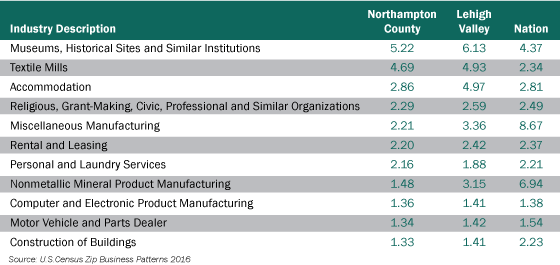
Transportation equipment manufacturing plus wholesale electronic markets are important sectors within the Nazareth Area, employing a higher concentration of people compared to the County, but lower than the regional and national levels:

Mining (except oil and gas), support activities for agriculture and forestry, and petroleum and coal products manufacturing are strong economic sectors for the Nazareth Area relative to Northampton County and the Lehigh Valley, but weaker than the nation:

Textile product mills, transit and ground passenger transportation and hospitals are stronger for the Nazareth Area than Northampton County, but have mixed strength relative to the Lehigh Valley and nation:

Of the seven economic sectors with medium scores relative to Northampton County, four have higher scores relative to the Lehigh Valley and four are higher relative to the nation. Fabricated metal product manufacturing nearly mirrors Northampton County, Lehigh Valley and the nation:
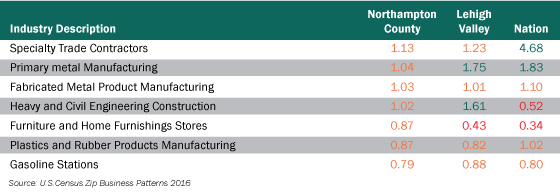
Nonstore retailers and paper manufacturing have low scores relative to Northampton County and the Lehigh Valley, but higher scores relative to the nation:

The remaining economic sectors have lower scores than Northampton County, Lehigh Valley and the nation, with the exception of merchant wholesalers, durable goods, which is slightly stronger than the national sector.
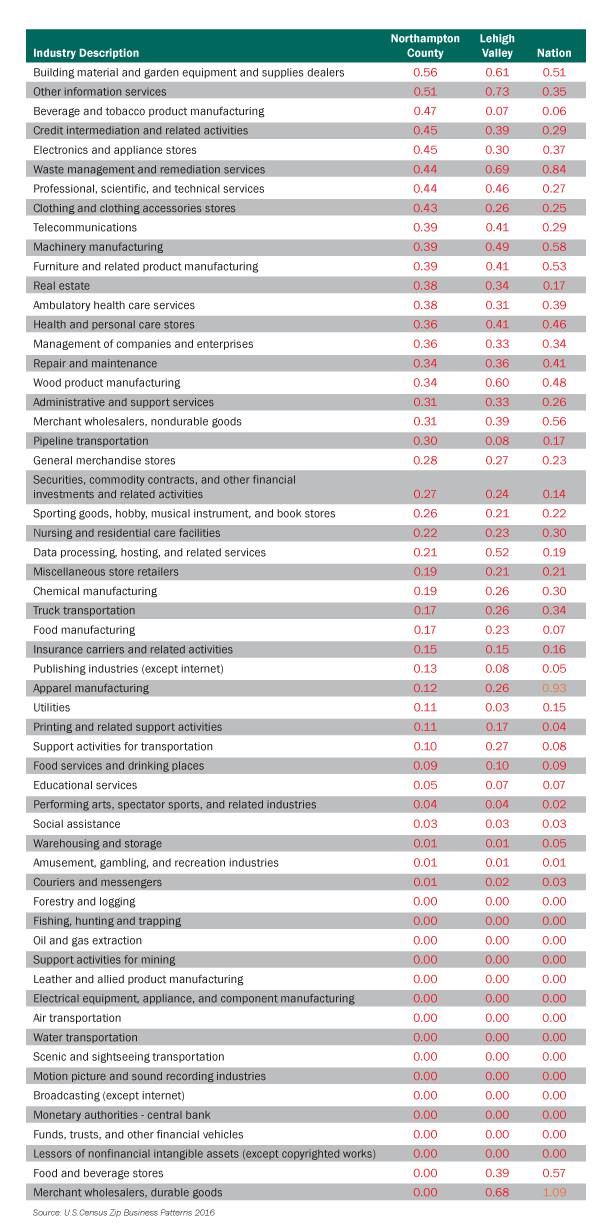
Economic Sector Trends
Methodology
The Economic Sector Trends analysis examines the job growth of industries in a given region over a ten-year time period and helps to identify how much of that growth is attributable to local competitive advantages versus national employment trends. In this analysis, industry employment changes within the Nazareth Area region are compared to industry employment changes at the national level from 2007 to 2016, using data from the U.S. Census 2016 Zip Business Patterns. This analysis is also referred to as a “Shift-Share Analysis”.
The Economic Sector Trends analysis is comprised of Expected Employment factors and Regional Growth factors:
Expected Employment
The Expected Employment factor identifies what the current-day employment number would be in a given industry based on the national growth of employment overall and in that industry within the last ten years. This captures two factors of national employment growth—the overall growth rate (also known as “National Share”) and growth rate within specific industries (also known as “Industry Mix”).
The rate of the nation’s overall employment growth in a given sector is significant because it reflects the growth of the American economy. The growth rate of specific industries reflects national changes related to specific industries. These two factors, when combined, show what employment would be within each Nazareth Area industry if the local industries matched the national trends, and therefore, indicates the overall effect of national employment changes on the Nazareth Area’s industries.
Regional Growth
Regional Growth indicates how much growth is attributable to local conditions. This explains what proportion of the employment change in each of the Nazareth Area’s industries is due to unique competitive advantages that the region possesses because the growth cannot be explained by national trends. This is found by subtracting Expected Employment from current employment.
The Data
The data for this analysis comes from the U.S. Census Bureau’s County Business Patterns, which is based on Business Register data that tracks U.S. business establishments by their Employer Identification Number (EIN) issued by the Internal Revenue Service. This is used by the company to report payroll taxes. Businesses operating without an EIN, or business with an EIN but without employees, are excluded from the dataset. The data for each industry is reported as number of establishments per size based on a range of employees (example: Utilities industry: 5-9 employees, 2 establishments). To estimate the number of employees for each industry, the midpoint of the range of employees was multiplied by the number of establishments.
Results
A first glance at the Economic Sector Trends analysis shows that several industries have grown at far greater rates locally than nationally, such as wholesale trade, real estate and leasing, healthcare, arts, entertainment and recreation, and transportation and warehousing. These industries exhibit a local influence that caused them to grow independent of national trends. Despite a 5% loss in real estate and leasing employment nationally, the industry employment in the Nazareth Area more than doubled.
However, several industries have experienced decline since 2007. Mining, construction, finance and insurance, and manufacturing industries have all experienced decline at both the local and national level. While employment decline in the construction industry is on par with the national rate, the mining industry experienced a significantly greater loss locally. This shows that, despite having high employment concentrations in the mining industry, the Nazareth Area is sharing in the same mining industry decline as the rest of the Lehigh Valley.
The arts, entertainment and recreation industry grew at a significant rate, affirming the potential for further economic growth in this industry. The accommodation and food services industry experienced a 9% decrease, meaning that investment may be required to stimulate the market for increased tourism and local restaurants. The data shows a general trend away from certain white collar jobs, such as professional services, management and administrative support, which may indicate the relocation of these jobs to other areas of the region. However, the data also shows an increase of other white collar jobs, including healthcare, educational services and real estate, which may mean that these businesses are increasing in presence within the Nazareth Area.
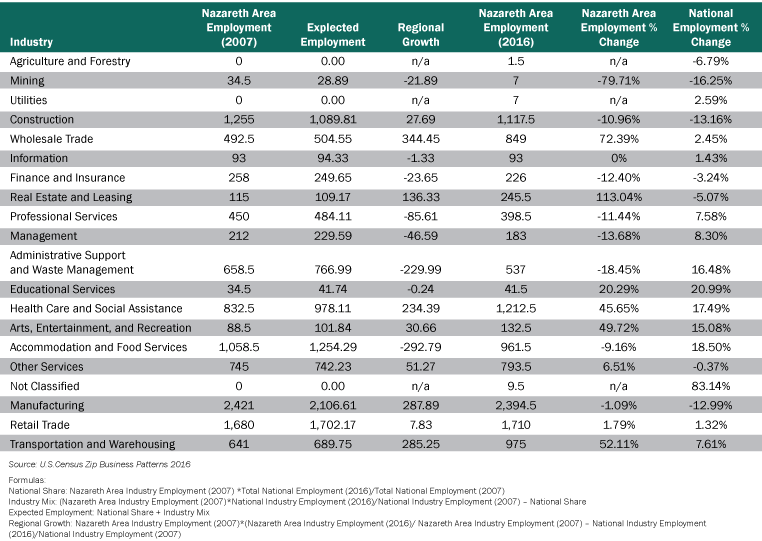
Commuting Patterns
Nearly 80% of all Nazareth Area commuters are staying in the Lehigh Valley to work, but the highest concentration of workers are commuting to the cities of Allentown and Bethlehem.
Fewer than 5,000 of the Nazareth Area’s nearly 22,000 workers stay in the Nazareth Area for employment, while nearly 4,000 travel to Allentown and Bethlehem combined. Though area workers commute to 50 of the Lehigh Valley’s 62 municipalities, the highest concentrations work in the three cities and their immediate suburbs.
The area also has its fair share of super commuters who travel as far as Washington D.C., Connecticut and Central Pennsylvania for work, with more than 500 working in Philadelphia and more than 130 commuting to Manhattan. In total, more than 4,400 people leave the Lehigh Valley to work. While some work from home, or travel to work a few times a week, many make long commutes daily. This shows that the region’s high quality of life has prompted many to travel long distances to remain residents of the Nazareth Area. It also highlights an opportunity that a more diversified job market could entice commuters to choose a local job if more options were available.
All Commuting
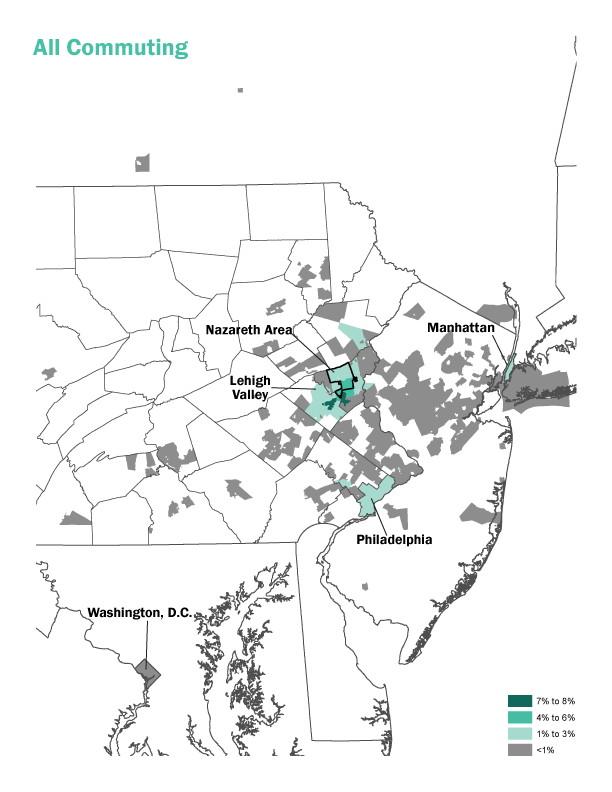
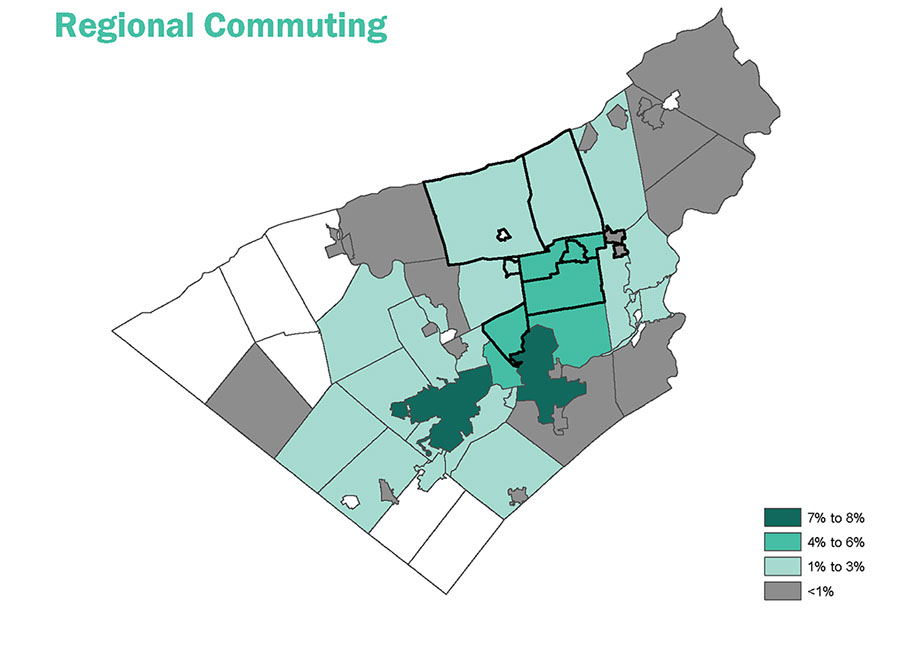
Summary
Regional Commuting
The Nazareth Area has 11 industries that are stronger than the same economic sectors for Northampton County, the Lehigh Valley and the nation. The Nazareth Area has 13 additional industries that are stronger than one or more of the three larger economies. These 24 industries provide a strong economic mix that could drive growth in these industries moving forward and spur growth in compatible industry sectors.
Overall, the Nazareth Area is keeping pace with economic changes observed at the national level, with a diversity of industries that are indicative of a strong economy. The economic sector trends show a decline in mining, finance, professional services, management and food service, with growth in wholesale trade, transportation and warehousing, leasing, healthcare, and arts, entertainment and recreation. The data generally shows a trend away from some professional industries and reflects the impact that the demands of increased e-commerce have had on the Lehigh Valley region.
The Nazareth Area has a strong healthcare base, with a high concentration of hospital employment. Other healthcare jobs have significantly lower concentrations of employment in the area, which may be an area of potential growth by building on the strengths of the area’s hospitals, particularly in light of recent plans by Lehigh Valley Health Network to build a new campus in Lower Nazareth Township.
The growth of the arts, entertainment and recreation industry indicates the potential to expand and capitalize on these businesses, which could also increase tourism in the Nazareth Area. The growth of this industry may also stimulate growth in the accommodation and food service industry as well.
Ultimately, the multi-municipal comprehensive plan will need to assess what type of economy and land use pattern local leaders and community members want to see for the Nazareth Area. The development of strong policies and actions to guide this growth appropriately will be key to supporting the future of the Nazareth Area and its residents.
